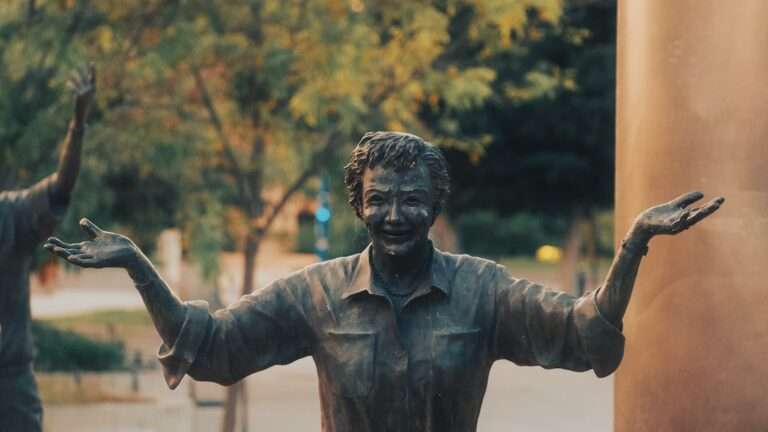Film Symbolism – A Comprehensive Guide
Film symbolism is a powerful tool used by filmmakers to convey deeper meanings and evoke emotions in their audience. It involves the use of visual, audio, and narrative elements to represent ideas, themes, or concepts that go beyond the surface level of the story. Film symbolism adds depth and complexity to a film, allowing viewers to engage with the story on a more profound level. In this article, we will explore the definition of film symbolism, its importance in cinema, its history from silent movies to modern blockbusters, the different types of film symbols, the role of color, objects and props, sound and music, nature, numbers and patterns in film symbolism, the interpretation of film symbols by audiences, and the future of film symbolism in the digital age.
The Definition of Film Symbolism and Its Importance in Cinema
Film symbolism can be defined as the use of visual, audio, and narrative elements to represent ideas, themes, or concepts that go beyond the surface level of the story. It is a way for filmmakers to communicate with their audience on a deeper level and evoke emotions or provoke thoughts. Symbolism in cinema is important because it adds depth and complexity to a film. It allows filmmakers to convey abstract or complex ideas in a more accessible and engaging way. By using symbols, filmmakers can create a visual language that transcends cultural barriers and speaks directly to the emotions and subconscious of the audience.
The History of Film Symbolism: From Silent Movies to Modern Blockbusters
The use of symbolism in film can be traced back to the early days of cinema. In silent movies, filmmakers relied heavily on visual symbols to convey meaning since there was no dialogue. For example, in F.W. Murnau’s 1922 film “Nosferatu,” the vampire Count Orlok is depicted with long fingers and sharp nails, symbolizing his predatory nature. This visual symbol effectively communicates his sinister character to the audience.
As cinema evolved, so did the use of symbolism. In modern blockbusters, filmmakers have a wide range of tools at their disposal to create symbolic meaning. They can use visual symbols, audio symbols, and narrative symbols to convey their intended message. For example, in Christopher Nolan’s 2010 film “Inception,” the spinning top is used as a visual symbol to represent the protagonist’s reality. The spinning top becomes a recurring motif throughout the film, leaving the audience questioning what is real and what is a dream.
The Different Types of Film Symbols: Visual, Audio, and Narrative
Film symbols can take various forms, including visual symbols, audio symbols, and narrative symbols. Each type of symbol has its own significance and contributes to the overall meaning of the film.
Visual symbols are perhaps the most common and easily recognizable form of film symbolism. They can be objects, colors, or even specific shots or compositions. For example, in Stanley Kubrick’s 1968 film “2001: A Space Odyssey,” the monolith is a visual symbol that represents the unknown and the evolution of humanity. Its simple black rectangular shape stands out against the vastness of space, creating a sense of mystery and awe.
Audio symbols are another powerful tool used by filmmakers to convey meaning. They can be sounds or music that evoke certain emotions or represent specific ideas or themes. For example, in Alfred Hitchcock’s 1960 film “Psycho,” the screeching violins in the famous shower scene have become an iconic audio symbol for terror and suspense.
Narrative symbols are elements within the story itself that carry symbolic meaning. They can be characters, events, or even recurring motifs. For example, in Francis Ford Coppola’s 1972 film “The Godfather,” oranges are used as a narrative symbol to foreshadow death or danger. Whenever oranges appear in a scene, it signals that something bad is about to happen.
The Role of Color in Film Symbolism: How Directors Use It to Convey Emotions
Color plays a significant role in film symbolism. Filmmakers use color to convey emotions, create atmosphere, and enhance the narrative. Each color has its own symbolic meaning and can evoke different emotions in the audience.
For example, the color red is often associated with passion, love, or danger. In Martin Scorsese’s 1990 film “Goodfellas,” the color red is used to symbolize violence and bloodshed. Whenever a character wears or interacts with something red, it foreshadows a violent event or signifies their involvement in criminal activities.
On the other hand, the color blue is often associated with calmness, tranquility, or sadness. In James Cameron’s 2009 film “Avatar,” the lush blue world of Pandora represents a peaceful and harmonious environment. The blue color palette creates a sense of serenity and beauty, contrasting with the harshness of the human world.
The Use of Objects and Props as Symbols in Film: From Rosebuds to Red Balloons

Objects and props can also be used as symbols in film to represent ideas or themes. They can be everyday objects or specific items that hold symbolic meaning within the context of the story.
For example, in Orson Welles’ 1941 film “Citizen Kane,” the sled named Rosebud is a powerful symbol that represents the lost innocence and happiness of the protagonist’s childhood. The sled appears throughout the film as a recurring motif, reminding the audience of Kane’s longing for a simpler time.
In another example, in Stephen King’s 1986 novel and subsequent 2017 film adaptation “It,” the red balloon is used as a symbol for Pennywise, the evil clown. The red balloon represents danger and serves as a warning sign for the characters in the story.
The Importance of Sound and Music in Film Symbolism: How They Enhance the Narrative
Sound and music play a crucial role in film symbolism. They can enhance the narrative, evoke emotions, and create a sense of atmosphere or tension.
For example, in Steven Spielberg’s 1975 film “Jaws,” the iconic two-note theme composed by John Williams has become synonymous with impending danger. The simple yet effective melody creates a sense of suspense and fear, alerting the audience to the presence of the shark.
In another example, in Darren Aronofsky’s 2010 film “Black Swan,” the use of Tchaikovsky’s “Swan Lake” as the main musical motif adds depth and complexity to the story. The music represents the duality of the protagonist’s character and mirrors her transformation from innocence to darkness.
The Symbolism of Nature in Film: From Sunsets to Storms
Nature is often used as a symbol in film to represent various ideas or themes. Filmmakers use natural elements such as sunsets, storms, or landscapes to convey emotions or create a specific mood.
For example, in Terrence Malick’s 2011 film “The Tree of Life,” nature is used as a symbol for spirituality and the interconnectedness of all living beings. The film is filled with stunning shots of nature, including vast landscapes and flowing rivers, which serve as a visual representation of the characters’ search for meaning and purpose.
In another example, in Ang Lee’s 2000 film “Crouching Tiger, Hidden Dragon,” rain is used as a symbol for emotional turmoil and inner conflict. The rain serves as a backdrop for intense fight scenes and reflects the characters’ emotional state.
The Symbolism of Numbers and Patterns in Film: How They Add Depth to the Story
Numbers and patterns can add depth to a film by creating a sense of order or highlighting specific themes or ideas. Filmmakers use numbers and patterns to convey hidden meanings or add layers of complexity to the story.
For example, in Christopher Nolan’s 2014 film “Interstellar,” the number 5 is used as a recurring motif throughout the film. The number represents the five dimensions of space-time and serves as a symbol for the protagonist’s journey through time and space.
In another example, in Stanley Kubrick’s 1980 film “The Shining,” patterns are used to create a sense of unease and disorientation. The iconic carpet pattern in the Overlook Hotel becomes a visual symbol for the protagonist’s descent into madness.
The Interpretation of Film Symbols: How Audiences Can Decipher Hidden Meanings
Audiences play a crucial role in interpreting film symbols. While filmmakers may have intended certain symbols to convey specific meanings, audiences can interpret them differently based on their own experiences and perspectives.
For example, in David Lynch’s 2001 film “Mulholland Drive,” the blue key is a visual symbol that represents the protagonist’s desire for control and power. However, audiences have interpreted the symbol in various ways, with some seeing it as a representation of the subconscious or a key to unlocking hidden truths.
In another example, in Christopher Nolan’s 2010 film “Inception,” the spinning top at the end of the film has sparked countless debates and interpretations among audiences. Some believe that the top falling signifies reality, while others argue that it represents a dream.
The Future of Film Symbolism: How It Will Continue to Evolve in the Digital Age
As technology continues to advance, so does the potential for film symbolism. With the advent of CGI and virtual reality, filmmakers have even more tools at their disposal to create immersive and symbolic experiences for their audience.
For example, in James Cameron’s 2009 film “Avatar,” the use of 3D technology enhances the immersive nature of the film and allows the audience to experience the world of Pandora in a more visceral way. The use of 3D technology adds depth and dimension to the visual symbols, creating a more immersive and engaging experience for the audience.
In another example, in Denis Villeneuve’s 2017 film “Blade Runner 2049,” the use of holographic projections as visual symbols adds a layer of complexity to the story. The holographic projections represent the blurred lines between reality and illusion, highlighting the themes of identity and memory.
Film symbolism is a powerful tool used by filmmakers to convey deeper meanings and evoke emotions in their audience. It adds depth and complexity to a film, allowing viewers to engage with the story on a more profound level. Through visual, audio, and narrative symbols, filmmakers can communicate abstract or complex ideas in a more accessible and engaging way. The future of film symbolism in the digital age holds great potential for even more immersive and symbolic experiences. As technology continues to advance, filmmakers will have even more tools at their disposal to create meaningful and impactful films. Film symbolism will continue to evolve and captivate audiences for years to come.
If you’re fascinated by the hidden meanings and deeper layers of symbolism in films, you’ll definitely want to check out this comprehensive guide on Film Symbolism. It delves into the intricate ways in which filmmakers use symbols to convey powerful messages and evoke emotions. As you explore the world of symbolism, you might also be interested in understanding the symbolism of the sun. This related article from Symbolism Hub explores the various interpretations and significance of the sun as a symbol. Discover how this celestial body has been used to represent life, energy, enlightenment, and much more. Read more
FAQs
What is film symbolism?
Film symbolism is the use of objects, characters, or actions to represent abstract ideas or concepts in a film. It is a technique used by filmmakers to convey deeper meanings and messages to the audience.
Why is film symbolism important?
Film symbolism is important because it adds depth and complexity to a film. It allows filmmakers to convey ideas and themes that may be difficult to express through dialogue or action alone. It also allows the audience to engage with the film on a deeper level and interpret the meaning behind the symbols.
What are some common symbols used in films?
Common symbols used in films include colors, animals, objects, and numbers. For example, the color red is often used to symbolize passion or danger, while the number three is often used to represent unity or completion.
How do filmmakers use symbolism in their films?
Filmmakers use symbolism in their films by incorporating objects, characters, or actions that represent abstract ideas or concepts. They may use recurring symbols throughout the film to reinforce a particular theme or message.
What are some examples of films that use symbolism?
Some examples of films that use symbolism include “The Matrix,” which uses the color green to represent the artificial world, and “The Shawshank Redemption,” which uses the character of the bird to symbolize freedom.
How can I analyze the symbolism in a film?
To analyze the symbolism in a film, you should look for recurring symbols and consider what they might represent. You should also consider the context in which the symbols are used and how they relate to the overall themes and messages of the film.





